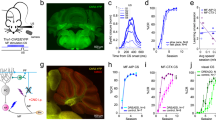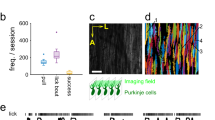Abstract
The climbing fiber input to the cerebellum from the inferior olive is thought to act as a teacher whose activity controls the induction of motor learning. We designed training conditions that did not elicit instructive signals in the climbing fibers, but nevertheless induced robust and consistent motor learning in the vestibulo-ocular reflex of rhesus monkeys. Our results indicate that instructive signals in the climbing fibers are not necessary for cerebellum-dependent learning. Instead, instructive signals carried by either the climbing fibers or Purkinje cell simple spikes may be sufficient to induce motor learning, with additive effects occurring when both instructive signals are present during training.
This is a preview of subscription content, access via your institution
Access options
Subscribe to this journal
Receive 12 print issues and online access
$209.00 per year
only $17.42 per issue
Buy this article
- Purchase on Springer Link
- Instant access to full article PDF
Prices may be subject to local taxes which are calculated during checkout





Similar content being viewed by others
References
Albus, J. A theory of cerebellar function. Math. Biosci. 10, 25–61 (1971).
Marr, D. A theory of cerebellar cortex. J. Physiol. (Lond.) 202, 437–470 (1969).
Ito, M. Neural design of the cerebellar motor control system. Brain Res. 40, 81–84 (1972).
Simpson, J.I. & Alley, K.E. Visual climbing fiber input to rabbit vestibulo-cerebellum: a source of direction-specific information. Brain Res. 82, 302–308 (1974).
Gilbert, P.F. & Thach, W.T. Purkinje cell activity during motor learning. Brain Res. 128, 309–328 (1977).
Ito, M. & Kano, M. Long-lasting depression of parallel fiber-Purkinje cell transmission induced by conjunctive stimulation of parallel fibers and climbing fibers in the cerebellar cortex. Neurosci. Lett. 33, 253–258 (1982).
Shutoh, F. et al. Memory trace of motor learning shifts transsynaptically from cerebellar cortex to nuclei for consolidation. Neuroscience 139, 767–777 (2006).
Boyden, E.S., Katoh, A. & Raymond, J.L. Cerebellum-dependent learning: the role of multiple plasticity mechanisms. Annu. Rev. Neurosci. 27, 581–609 (2004).
Boyden, E.S. et al. Selective engagement of plasticity mechanisms for motor memory storage. Neuron 51, 823–834 (2006).
De Zeeuw, C.I. & Yeo, C.H. Time and tide in cerebellar memory formation. Curr. Opin. Neurobiol. 15, 667–674 (2005).
Lisberger, S.G. & Sejnowski, T.J. Motor learning in a recurrent network model based on the vestibulo-ocular reflex. Nature 360, 159–161 (1992).
Jörntell, H. & Ekerot, C.F. Reciprocal bidirectional plasticity of parallel fiber receptive fields in cerebellar Purkinje cells and their afferent interneurons. Neuron 34, 797–806 (2002).
Lisberger, S.G. Neural basis for motor learning in the vestibuloocular reflex of primates. III. Computational and behavioral analysis of the sites of learning. J. Neurophysiol. 72, 974–998 (1994).
Medina, J.F. et al. Mechanisms of cerebellar learning suggested by eyelid conditioning. Curr. Opin. Neurobiol. 10, 717–724 (2000).
Hirata, Y. & Highstein, S.M. Acute adaptation of the vestibuloocular reflex: signal processing by floccular and ventral parafloccular Purkinje cells. J. Neurophysiol. 85, 2267–2288 (2001).
Jirenhed, D.A., Bengtsson, F. & Hesslow, G. Acquisition, extinction and reacquisition of a cerebellar cortical memory trace. J. Neurosci. 27, 2493–2502 (2007).
Coesmans, M. et al. Bidirectional parallel fiber plasticity in the cerebellum under climbing fiber control. Neuron 44, 691–700 (2004).
Lev-Ram, V. et al. Reversing cerebellar long-term depression. Proc. Natl. Acad. Sci. USA 100, 15989–15993 (2003).
Rancillac, A. & Crepel, F. Synapses between parallel fibres and stellate cells express long-term changes in synaptic efficacy in rat cerebellum. J. Physiol. (Lond.) 554, 707–720 (2004).
Shinoda, Y. et al. The entire trajectory of single climbing and mossy fibers in the cerebellar nuclei and cortex. Prog. Brain Res. 124, 173–186 (2000).
Evans, G.J. Synaptic signaling in cerebellar plasticity. Biol. Cell 99, 363–378 (2007).
Mittmann, W. & Hausser, M. Linking synaptic plasticity and spike output at excitatory and inhibitory synapses onto cerebellar Purkinje cells. J. Neurosci. 27, 5559–5570 (2007).
Miles, F.A. & Lisberger, S.G. Plasticity in the vestibulo-ocular reflex: a new hypothesis. Annu. Rev. Neurosci. 4, 273–299 (1981).
Haddad, G.M., Demer, J.L. & Robinson, D.A. The effect of lesions of the dorsal cap of the inferior olive on the vestibulo-ocular and optokinetic systems of the cat. Brain Res. 185, 265–275 (1980).
Mintz, M. et al. Unilateral inferior olive NMDA lesion leads to unilateral deficit in acquisition and retention of eyelid classical conditioning. Behav. Neural Biol. 61, 218–224 (1994).
Zbarska, S., Bloedel, J.R. & Bracha, V. Cerebellar dysfunction explains the extinction-like abolition of conditioned eyeblinks after NBQX injections in the inferior olive. J. Neurosci. 28, 10–20 (2008).
Colin, F., Manil, J. & Desclin, J.C. The olivocerebellar system. I. Delayed and slow inhibitory effects: an overlooked salient feature of cerebellar climbing fibers. Brain Res. 187, 3–27 (1980).
Rambold, H. et al. Partial ablations of the flocculus and ventral paraflocculus in monkeys cause linked deficits in smooth pursuit eye movements and adaptive modification of the VOR. J. Neurophysiol. 87, 912–924 (2002).
Robinson, D.A. Adaptive gain control of vestibuloocular reflex by the cerebellum. J. Neurophysiol. 39, 954–969 (1976).
Torte, M.P. et al. Anatomical segregation of different adaptative processes within the vestibulocerebellum of the cat. Exp. Brain Res. 99, 441–454 (1994).
Ito, M., Jastreboff, P.J. & Miyashita, Y. Specific effects of unilateral lesions in the flocculus upon eye movements in albino rabbits. Exp. Brain Res. 45, 233–242 (1982).
Cohen, H. et al. Habituation and adaptation of the vestibuloocular reflex: a model of differential control by the vestibulocerebellum. Exp. Brain Res. 90, 526–538 (1992).
Miles, F.A. et al. Long-term adaptive changes in primate vestibuloocular reflex. III. Electrophysiological observations in flocculus of normal monkeys. J. Neurophysiol. 43, 1437–1476 (1980).
Lisberger, S.G. & Fuchs, A.F. Role of primate flocculus during rapid behavioral modification of vestibuloocular reflex. I. Purkinje cell activity during visually guided horizontal smooth-pursuit eye movements and passive head rotation. J. Neurophysiol. 41, 733–763 (1978).
Eccles, J.C., Llinas, R. & Sasaki, K. The excitatory synaptic action of climbing fibres on the purinje cells of the cerebellum. J. Physiol. (Lond.) 182, 268–296 (1966).
Raymond, J.L. & Lisberger, S.G. Neural learning rules for the vestibulo-ocular reflex. J. Neurosci. 18, 9112–9129 (1998).
Ito, M., Nisimaru, N. & Yamamoto, M. Specific patterns of neuronal connexions involved in the control of the rabbit's vestibulo-ocular reflexes by the cerebellar flocculus. J. Physiol. (Lond.) 265, 833–854 (1977).
Maekawa, K. & Takeda, T. Origin of descending afferents to the rostral part of dorsal cap of inferior olive which transfers contralateral optic activities to the flocculus. A horseradish peroxidase study. Brain Res. 172, 393–405 (1979).
Ilg, U.J. & Hoffmann, K.P. Responses of neurons of the nucleus of the optic tract and the dorsal terminal nucleus of the accessory optic tract in the awake monkey. Eur. J. Neurosci. 8, 92–105 (1996).
Mustari, M.J. & Fuchs, A.F. Discharge patterns of neurons in the pretectal nucleus of the optic tract (NOT) in the behaving primate. J. Neurophysiol. 64, 77–90 (1990).
Ohyama, T. et al. Learning-induced plasticity in deep cerebellar nucleus. J. Neurosci. 26, 12656–12663 (2006).
Lisberger, S.G., Pavelko, T.A. & Broussard, D.M. Neural basis for motor learning in the vestibuloocular reflex of primates. I. Changes in the responses of brain stem neurons. J. Neurophysiol. 72, 928–953 (1994).
Han, V.Z. et al. Synaptic plasticity and calcium signaling in Purkinje cells of the central cerebellar lobes of mormyrid fish. J. Neurosci. 27, 13499–13512 (2007).
Hartell, N.A. Strong activation of parallel fibers produces localized calcium transients and a form of LTD that spreads to distant synapses. Neuron 16, 601–610 (1996).
Medina, J.F., Garcia, K.S. & Mauk, M.D. A mechanism for savings in the cerebellum. J. Neurosci. 21, 4081–4089 (2001).
Raymond, J.L. & Lisberger, S.G. Behavioral analysis of signals that guide learned changes in the amplitude and dynamics of the vestibulo-ocular reflex. J. Neurosci. 16, 7791–7802 (1996).
Robinson, D.A. A method of measuring eye movement using a scleral search coil in a magnetic field. IEEE Trans. Biomed. Eng. 10, 137–145 (1963).
Acknowledgements
We thank P. Louderback and R. Levine for technical assistance, and E. Knudsen, D. Angelaki, M. Goldman, D. Fisher, I. Witten, E. Mukamel, A. Katoh, R. Kimpo, B. Nguyen-Vu and S.-L. Shin for their comments on the manuscript. This work was supported by the US National Institutes of Health (grants R01 DC004154 to J.L.R. and F31 DC008078 to M.C.K.), a Howard Hughes Medical Institute fellowship for Medical Students and the Stanford Medical Scientist Training Program to M.C.K. and a Stanford Graduate Fellowship to C.C.G.
Author information
Authors and Affiliations
Contributions
M.C.K. and C.C.G. performed the experiments and analyzed data. M.C.K., C.C.G. and J.L.R. wrote the manuscript. J.L.R. provided guidance throughout the project.
Corresponding author
Supplementary information
Supplementary Text and Figures
Supplementary Figures 1–7 and Supplementary Table 1 (PDF 1177 kb)
Rights and permissions
About this article
Cite this article
Ke, M., Guo, C. & Raymond, J. Elimination of climbing fiber instructive signals during motor learning. Nat Neurosci 12, 1171–1179 (2009). https://doi.org/10.1038/nn.2366
Received:
Accepted:
Published:
Issue Date:
DOI: https://doi.org/10.1038/nn.2366
This article is cited by
-
Cerebellar Representations of Errors and Internal Models
The Cerebellum (2022)
-
Mid-lateral cerebellar complex spikes encode multiple independent reward-related signals during reinforcement learning
Nature Communications (2021)
-
Autonomous Purkinje cell activation instructs bidirectional motor learning through evoked dendritic calcium signaling
Nature Communications (2021)
-
Plasticity leading to cerebellum-dependent learning: two different regions, two different types
Pflügers Archiv - European Journal of Physiology (2019)
-
Modulation of sensory prediction error in Purkinje cells during visual feedback manipulations
Nature Communications (2018)



